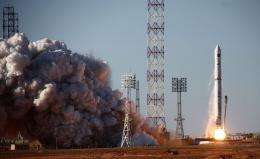Russian space telescope unfurls giant antenna

A giant new Russian space telescope on Saturday unfurled its dish-like antenna which will observe radio waves from galaxies and black holes billions of light years away.
The operation to deploy the 10-metre-diameter antenna of the Spketr-R telescope, which was launched into orbit on Monday, has been successfully carried out, space agency Roskosmos said in a statement.
"According to telemetry data, the planned programme was carried out in full," Roskosmos said.
Interfax said scientists at the Lavochkin institute outside Moscow had begun on Friday the tricky operation to open up the plates of the dish like petals on a flower but initially encountered potentially major problems.
"It was not possible on Friday for all 27 of the petals to go into their final position despite numerous attempts to open them," a space industry source, who was not named, told the agency.
A fresh attempt was made on Saturday and now all the petals are in their working position, the source said.
Had the antenna not unfurled properly, it would have been a terminal problem as the telescope would not have been able to focus on deep space objects, the source said.
The telescope is going to point itself at the moon in a test phase and will start its programme of exploring deep space objects in around three months, Interfax said.
The radio space telescope's launch was a major event in the Russian space programme, marking its first deep space project in years and heralding a return to cosmic exploration.
Dubbed the "Russian Hubble" after the iconic US space telescope, the Russian instrument will in fact be able to produce images with a resolution many thousand times greater.
The telescope will look at quasars, high-energy galactic centres in the distant universe, fast-spinning pulsar star remnants and also massive black holes. It will have a minimum working life of at least five years.
Russia is due in November to finally launch its eagerly-awaited Fobos-Grunt probe, which will seek to return a soil sample from the Martian moon Phobos to Earth and also observe the Red Planet.
Celebrating the 50th anniversary year of Yuri Gagarin's first manned space flight, Russia is hoping to show it remains a global power in space science despite a string of setbacks over the last years.
With the end of the US space shuttle programme, it has now become the sole nation capable of transporting humans to the International Space Station (ISS).
(c) 2011 AFP

















